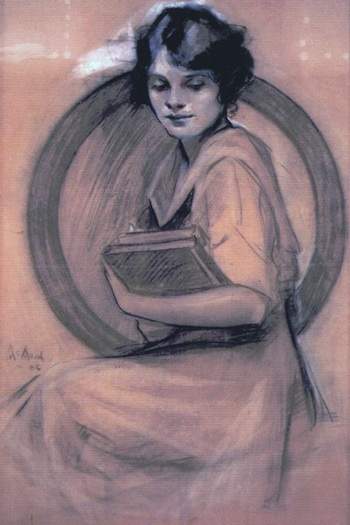Local woman remembered for famous portraits

Many people know Betty Crocker is not a real person. Not many people know how she came into being, or that a Quincy woman drew her.
In 1936, General Mills commissioned an artist to draw a portrait of the kitchen maven. The artist combined features from female workers at General Mills for Betty Crocker’s face. That artist was Quincy native Neysa McMein.
In 1888, Harry Moran and Isabelle Parker McMein welcomed their baby girl into the world; they christened her Marjorie Frances McMein. Young Marjorie appeared to appreciate and show talent for music, acting, and art. She did not ignore her academics. She graduated from Quincy High School with honors in 1907.
At a time when only around three percent of the female population attended college, McMein left home for Chicago and enrolled at the Chicago Art Institute. She dabbled in acting and music. Despite interest and potential, McMein decided to focus on her visual art. After her schooling, she became the lead designer for a large millinery institution.
Ever ambitious, McMein left her post and traveled to New York in 1911. Like many young people who move to a big city, McMein struggled to find her place for a time. She would eventually make a living and then some. At the height of her career McMein made $2,500 for every portrait.
Not long after her move to New York, World War I shocked the nation. Never one to sit idly, McMein drew pictures that were used on wartime posters. Most of her work was used by the Red Cross in support of special drives. She became a YMCA entertainer and traveled to U.S. camps all over France. Her father died in 1918 while she was abroad, bringing her back home to take care of her mother.
While in town McMein spoke at a war fund drive at the Empire Theatre on Nov. 13. The theater was so crowded and the talk so popular that McMein spoke again the next night. When recalling the engagement Sarah Carney said, “[McMein] was the main attraction. The theater was filled. She was an excellent speaker; very witty and clever.” After this trip to Quincy, McMein brought her mother back to New York, where Belle McMein stayed with her daughter until her death in 1923. That same year McMein married mining engineer John Baragwanath.
New York not only allowed McMein to launch her career, but the city also launched her life as Neysa. There are differing accounts as to why the name change took place. The story from her husband is that she took a liking to the name after meeting a filly named Neysa when visiting the stables of Homer Davenport. Another story states that her numerologist suggested the change in name as a pathway to success. McMein herself said that her new name had a commercial value that her baptismal name lacked.
Whether spurred on by her new name or more likely her own talent, success did come to Neysa McMein. She became a premiere artist of magazine covers and was known for her “All American Girls.” Her clients included McClure’s, Saturday Evening Post, Woman’s Home Companion, Colliers, and National Geographic magazines. She also worked on advertising campaigns for brands such as Colgate, Lucky Strike, and Cadillac. Her largest account came from McCall’s Magazine. She drew a cover-girl every month for McCall’s from 1928 to 1937.
She also enjoyed acceptance at the Algonquin Round Table, or Vicious Circle, which met at the Algonquin Hotel in New York. The Circle encompassed the upper crust of writers, critics, actors, actresses and playwrights. Other members included Dorothy Parker, Edna Ferber, Harpo Marx, Alexander Woollcott, and Herman Mankiewicz. Outside this group, McMein also made fast friends with people like Irving Berlin, Walt Disney, Cole Porter, and Ethel Barrymore.
By all accounts, McMein did not differentiate between her friends in the Vicious Circle and her friends from home. For instance, some of the inspiration for her covers came from hometown friends whom she would sketch on visits. Quincyans had their pictures hung right alongside the likes of President Harding, President Hoover, Edna St. Vincent Millay, Helen Hayes, and Amelia Earhart.
On May 12, 1949, McMein died, survived by her husband and their daughter Joan. The last portrait she drew was of English actress Bea Lillie.
Upon her death the Whitney Museum of American Art established the Neysa McMein Purchase Award, which is used to purchase work by living American artists.
Bridget Quinlivan is a recent history graduate from Quincy University and Western Illinois University. She is a volunteer and seasonal employee at the Historical Society and an English/ Writing Specialist for Student Support Services at John Wood Community College.
Sources
"Early College Women: Determined To Be Educated." http://www.northnet.org/stlawrenceaauw/college.htm .
Quincy Herald-Whig, May 13, 1949.
Landrum, Carl. "Neysa McMein: Quincy's Cover-Girl Artist." Quincy Herald-Whig, April 7, 1996.
Prunkl, Pete and J. Hugh Smith. "A Biographical Sketch of Neysa McMein." The Illustrator Collector's News, Nov-Dec. 1987.
Stahl, Marie. "Society." The Quincy Whig, Aug 27, 1915.
Additional Information
Gallagher, Brian. Anything Goes: The Jazz Age Adventures of Neysa McMein and her Extravagant Circle of Friends. New York: Times Books, 1987.






